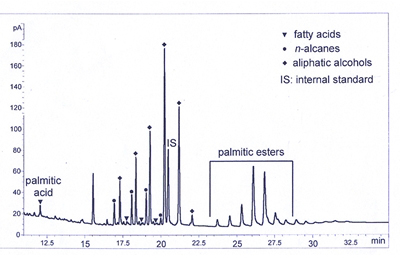Home > The archaeological research at Dikili Tash > organic residue Analysis
organic residue Analysis
 Organic residues may either be preserved as a crust on a ceramic surface or through impregnation of porous vessel walls. They are usually amorphous. Residues preserve in very small quantities and are often highly degraded, identifiable only in how they correspond to complex molecular compositions. A range of physicochemical analytical techniques are used for their characterization, such as Fourier Transform Infrared Spectroscopy and Gas Chromatography combined with Mass Spectrometry. Taking into account the properties of the identified materials (e.g., subcutaneous animal fat, dairy products, vegetal oils, wax, or adhesives), one can create inferences regarding the use of vessels..
Organic residues may either be preserved as a crust on a ceramic surface or through impregnation of porous vessel walls. They are usually amorphous. Residues preserve in very small quantities and are often highly degraded, identifiable only in how they correspond to complex molecular compositions. A range of physicochemical analytical techniques are used for their characterization, such as Fourier Transform Infrared Spectroscopy and Gas Chromatography combined with Mass Spectrometry. Taking into account the properties of the identified materials (e.g., subcutaneous animal fat, dairy products, vegetal oils, wax, or adhesives), one can create inferences regarding the use of vessels..

